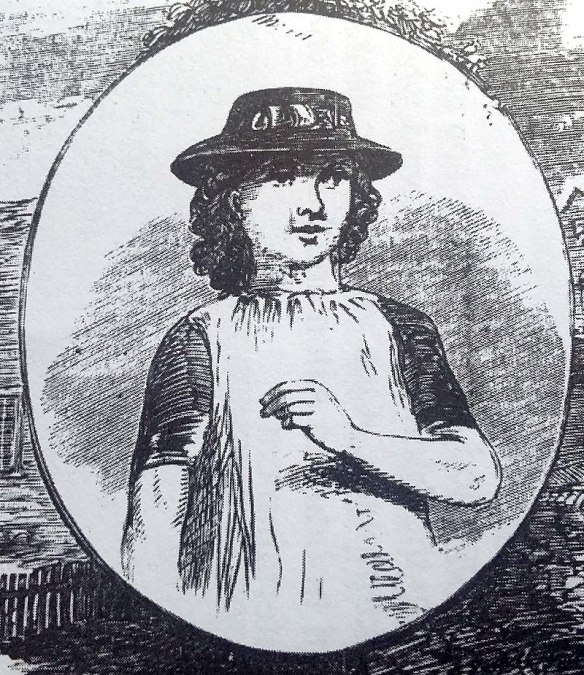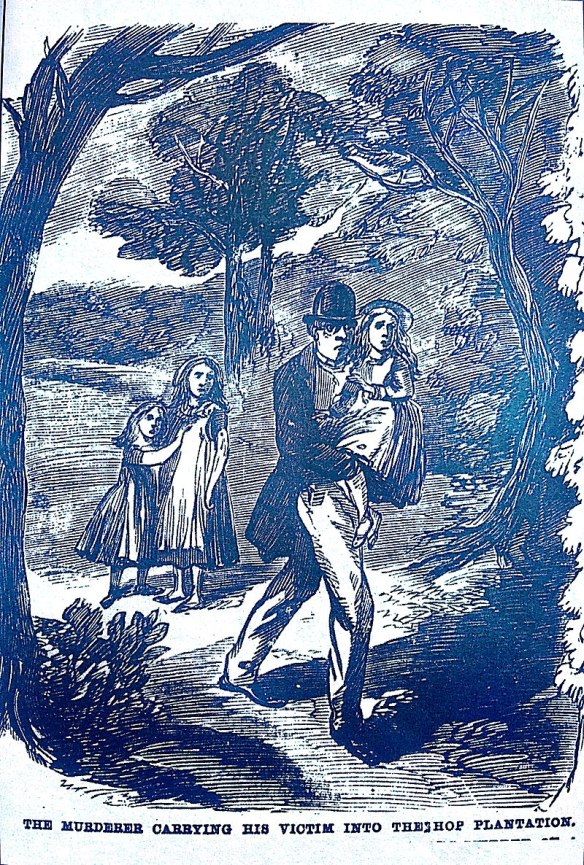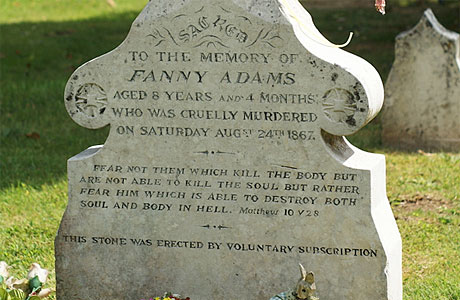Late in the evening on the 24th of August 1859, a farm labourer by the name of Thomas Gibson was on his way to tend to some crops when she decided to walk through a local hop garden. It was a pleasant little area, a little way from the River Wey that connected to the floor meadows where children were known to play.
As he walked through the hop garden something caught between two hop poles caught his attention. The light was low but he had enough to become curious as to what had been placed there. At first, he thought that maybe it might have been something that the local children had been playing with but once he got closer he was shocked to find that it was not the play toy of a child at all. It was the decapitated head of a female child.
Not too far away in the meadow, a search party was gathering to find eight-year-old Fanny Adams, who had not been seen since early in the afternoon. Described as tall, comely and intelligent; Fanny, her younger sister Lizzie and her best friend Minnie Warner had gone to play in the local flood meadows after asking Fanny’s mother if it was ok. Once they had been told that they were free to go, the three girls had disappeared to play but only Lizzie and Minnie had returned.
No one had become worried about where Fanny had disappeared until about 5 pm when one of the girl’s neighbours, Mrs Gardner, had noticed that Fanny was not playing with them. When she had inquired as to where Fanny was, the two girls had told them about a man who had given them money for sweets and fed them blackberries.
After a little while, both Lizzie and Minnie decided they had had enough and wanted to go home. The man then asked if Fanny would accompany him to Shalden. When Fanny refused, he had picked the young girl up and walked off with her.

Illustrated Police portrait of Fanny Adams. Picture Credit: Wikipedia Commons
The two girls had then run back to Minnie’s home where they had tried to inform Minnie’s mother about what had happened but due to the housework that Martha Warner still had to complete, the story the two girls told fell onto distracted ears. When they had not received any acknowledgment regarding their story, Lizzie and Minnie had returned to playing.
Concerned, Mrs Gardner retold the story to Fanny’s mother and together the two women went out in search of Fanny with Minnie accompanying them. At the gate to the local hop garden, the three ran into a man that Minnie recognised as Fredrick Baker, a local solicitors clerk, and the man that had given them money for sweets and had taken Fanny.
Dressed in a frock coat, light coloured trousers and a tall hat, Fredrick Baker was a new addition to the local town as he had only moved to the area two months before. Once Minnie had identified him, Harriet Adams asked him for his name because although she was familiar with his face she had never been formally introduced to him. Baker refused and instead told her where she would be able to find him.
Mrs Gardner then asked where Fanny was and Baker replied that they should not worry, that the last he had seen her was when he had left her at the gate to the hop garden, where she had walked off to continue playing. He also commented that he often gave money to children for sweets and that he never had any ill intentions by it. Feeling unsure about Baker, Mrs Gardner told him: “I have a great mind to give you in charge of the police” to which Baker replied: “You can do as you like”.
Because of his position in the town working for the local solicitor, the women did not believe that he could have done anything to the little girl and had then returned home with the belief that Fanny was still out playing.
When Fanny had still not returned home later that night, Harriet Adams started to gather others and a search began for the eight-year-old. They searched all over meadow but despite their best efforts, there was no sign of her. As the search party moved on, Thomas Gates emerged from the hop garden and told them all of his discovery.
The group quickly followed Gates and soon everyone was aware of what had happened to Fanny Adams.

Illustration of Fanny Adams Abdutction. Picture Credit: Wikipedia Commons
Fanny had been dismembered in a mixture of careful cuts and rough tears, resulting in her head, arms and legs being removed from her torso. Her head had been stuck between two hop poles and held large cuts from her mouth to ear and on her temple. He eyes were missing but would not be discovered until later in the River Wey.
On the left side of her chest, there were three very deep cuts on her left side and there was a deep cut on her left arm that divided the muscle. Her forearm had been removed at the elbow joint, her left leg had almost been completely severed from her body and her left foot had been completely removed. Her right leg had been torn away from her body roughly and all of her organs had been removed from her torso. Her liver held five incisions, her heart had been cut out and her vagina was missing.
The locals began to search for Fanny’s remains, gathering them together and taking them away so that they could be sewn back together. Most of her remains were able to be found that night but an arm, foot, and her intestines were not found until the next day and her breastbone was never recovered. With the exception of her hat, the search party recovered all of her clothing and it was all taken away from the hop garden.
After being told what had been discovered in the hop garden, Harriet Adams tried to tell her husband what had happened to their daughter but the stress and grief of the situation hit her and she collapsed before she was able to reach him. Word was sent to George Adams and once he had heard of what had happened, he returned home for his shotgun so he could search for the man who had murdered his daughter. Neighbours became aware of George’s plan however and were able to stop him before he left his house and stayed with him all night to ensure that he did no harm someone innocent.
Upon getting word about what was happening in the flood meadows, Police Superintendent Willian Cheyney left the local police station to go to the flood meadows at 9 pm. Once he had arrived he was then lead to the Leathern Bottle, where he was handed a bundle that had a note that read portions of a child. From there, he and other police officers organised an official search of the area to recover anything that had not been found and any evidence that the murderer had left behind.
The police’s search of the area recovered very little. Well-meaning locals had unfortunately trampled the crime scene, making it hard for the police to find anything that could lead them to a killer. They were able to find a possible murder weapon as laying in the garden was a stone that was covered in hair and blood.
As Cheyney started to put together what had happened, he started to hear stories about Fredrick Baker and how he had last been seen with Fanny Adams. Retracing his steps through town, Cheyney found Baker at his place of work but immediately found it odd that Baker was still there as normally he would have finished work an hour earlier.
Baker proclaimed his innocence, even after being told that he was the only suspect in the murder. As other inquiries lead nowhere, Cheyney was left with no choice but to arrest Baker and smuggling him out of the solicitor’s office due to the crowd that was beginning to gather outside.
At the police station, Cheyney ordered a search of Baker. The search recovered two small knives and blood on the wristband of his shirt. Closer inspection of his trousers found that while they were soaked there was also signs of blood which gave the impression that they had been soaked with water in the hope of hiding the blood. Throughout the search, Baker remained cool and collected and gave off no outward signs that he was worried that he was being arrested for murder and there were no outward signs of insanity as well.
After ensuring the Baker was safe inside the police station, Cheyney returned to the solicitor’s office and began to search Bakers desk. It was mostly covered in legal papers but after searching through all of the papers Cheyney discovered a journal. Flipping through, Cheyney found the most recent entry and what was written was enough to make Cheyney believe that they had arrested the right man.
An entry dated Saturday 24th of August read: Killed a young girl. It was fine and hot.
From there, reports started to come in regarding Baker’s personality in the hours after the murder. Some reports stated that he had appeared intoxicated after seeing the girls in the meadow but those reports were then refused by witnesses saying that Baker did not seem or smell like he had been drinking at all.
Three days after Fanny’s death an inquest was held as was required by British law of the time in regards to suspicious deaths. County Coroner Robert Harfield was in charges of the proceedings and Minnie Warner was the first to give evidence. Her recount of the events a few days before held true to what she had told Mrs Gardner a few days before but when it came to identifying Baker as the man who had taken Fanny she was unable to do so. She was, however, able to positively identify and describe what Baker had been wearing that day.
Harriet Adams was next and she retold the meeting between herself, Minnie, Mrs Gardner, and Baker. Mrs Gardner’s statement was next and she corroborated what Harriet Adams said of their meeting with Baker. Describing Baker as very relaxed at the time of their meeting she was able to positively identify him before finishing her statement. Baker was given a chance to cross-examine them but declined.

Death Record for Fanny Adams. Picture Credit: Hantsweb
Investigations continued after the inquest. A young boy came forward stating that he had seen Baker emerge from the hop garden around 2 pm on the day Fanny had been killed. He described Baker as covered in blood and the man had walked down to the River Wey to clean himself up.
After washing himself, the boy saw Baker pocket a small knife and an unknown weapon before walking off. The boy had later told his mother what he had seen but his mother had been unsure about coming forward. A search of the area after the boy gave his statement did no recover any new evidence. By the 19th of September the hop garden was cleared and a month later Baker was transferred to Winchester Prison. With no further evidence found, Cheyney ordered forensic tests to be done.
Professor A S Taylor examined the blood on Bakers knives and clothes and was able to confirm that it was human. Close examination of the knives found coagulated blood but there was none on the handle and Taylor would go on to say that if the knives had been washed with water he would have expected to find rust and if they had not been washed with water, he would have expected to find more blood. Closer examinations of Bakers clothes resulted in the discovery of diluted blood on his waistcoat, trousers, and stockings. Taylor also speculated that with the right tools, an inexperienced man would be able to dismember a body in half an hour.
It was local doctor Lewis Leslie who would determine Fanny’s cause of death as blunt force trauma and speculated that it was possible that the rock that had been found was the murder weapon. His examination of the body allowed him to come to the conclusion that Fanny had still been warm when she had been dismembered.
However, he did not agree with Taylor’s speculation that small knives could have dismembered Fanny’s body the way it had been. It was his belief that larger tools would have been needed to do the damage that had been done but he did agree with Taylor that if someone had the right tools that dismemberment could be done in less than an hour. He also believed that if Baker positioned himself in certain ways during the dismemberment, he would have been able to ensure that he did not get drenched in blood.
While the forensic tests were being done, Baker became very chatty with the guards and warden at the Winchester Hotel. During his chats, he would proclaim that his conscience was clear and he wondered whether or not they would ever capture the guilty party and that he hoped that they caught the actual murderer.
The guards and warden would also report a stark change in Baker’s personality compared to when he was in Alton. While in Alton, Baker was said to have nightmares and sleep horribly and the sight of meat would make him shudder. However since his arrival at Winchester Prison Baker had done a complete turnaround and was eating and sleeping normally.
Fredrick Baker went on trial on the 5th of December and his defence was ready to contest Minnie’s identification and claim that the knives that were found in his possession were too small to butcher Fanny Adams with. With these claims were their arguments of a family history of insanity; with a violent father, a cousin who had been in a number of asylums and a sister with brain fever, it made sense that Baker could have a genetic disposition to insanity. Their claim was backed up with the reports that Baker had tried to commit suicide years before. Their final argument came down to the way the diary entry was made; it was a very formal entry and that the lack of a comma did not mean that it was a confession.
Fifteen minutes after the jury was asked to leave to deliberate, they returned to the courtroom with their verdict: guilty. Before his death Baker wrote to George and Harriet Adams, expressing his sorrow over what he had done to Fanny and asking for their forgiveness. Whether or not he got it is unknown and on the 24th of December Fredrick Baker was hanged outside Winchester prison with a crowd of five thousand watching.

Fanny Adams Headstone. Picture Credit: BBC America
After the inquest, Fanny Adams was buried in her local cemetery. Her headstone is still standing today and reads: Sacred to the memory of Fanny Adams aged 8 years and 4 months who was cruelly murdered on Saturday, August 24th, 1867. Fear not them which kill the body but are not able to kill the soul but rather fear Him which is able to destroy both body and soul in hell. Matthew 10 v 28.
In 1869 rations were introduced to British seamen for the first time. They were very unimpressed with what they were given and suddenly the joke started that they had been given the butchered remains of Fanny Adams.
Fanny Adams soon became slang for mutton or stew and then from there to transformed to mean anything that was considered worthless. It eventually transformed into the saying “Sweet Fanny Adams” and then was shortened to “Sweet F.A”, which these days is seen as a euphemism for “fuck all”
Sources:
McAlpine, Fraser. (n.d). Fraser Phrases: The Gruesome Story of Sweet Fanny Adams. BBC America.
http://www.bbcamerica.com/anglophenia/2012/01/frasers-phrases-the-gruesome-story-of-sweet-fanny-adams
Hampshire Cultural Trust. (n.d). The True Story of Sweet Fanny Adams.
https://www.hampshireculturaltrust.org.uk/content/true-story-sweet-fanny-adams
Hampshire Genealogy Society. (n.d). Who Was Sweet Fanny Adams
Hantsweb. (n.d.). The True Story of Sweet Fanny Adams.
https://web.archive.org/web/20081203095919/http://www3.hants.gov.uk/museum/curtis-museum/alton-history/fanny-adams.htm
Wikipedia. (n.d). Fanny Adams.
https://en.wikipedia.org/wiki/Fanny_Adams